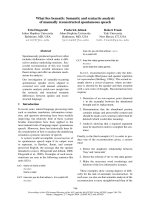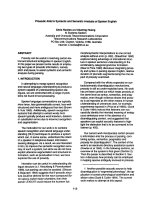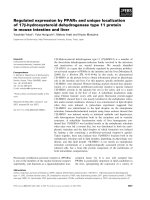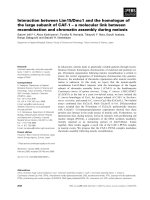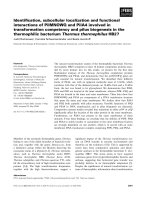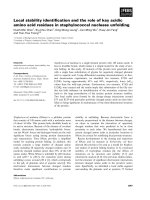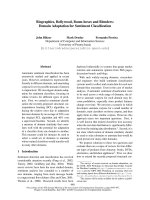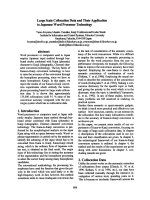Báo cáo khoa học: Viral entry mechanisms: cellular and viral mediators of herpes simplex virus entry potx
Bạn đang xem bản rút gọn của tài liệu. Xem và tải ngay bản đầy đủ của tài liệu tại đây (452.01 KB, 9 trang )
MINIREVIEW
Viral entry mechanisms: cellular and viral mediators of
herpes simplex virus entry
Jihan Akhtar
1
and Deepak Shukla
1,2
1 Department of Ophthalmology and Visual Sciences, College of Medicine, University of Illinois at Chicago, IL, USA
2 Department of Microbiology and Immunology, College of Medicine, University of Illinois at Chicago, IL, USA
Introduction
The herpesvirus family consists of over 100 double-
stranded DNA viruses divided into a, b and
c subgroups [1]. Only eight herpesviruses are known to
commonly infect humans and the remainder are
animal herpesviruses infecting a wide variety of animal
species. All members of the herpesvirus family cause
lifelong latent infections and, structurally, all have a
linear, double-stranded DNA genome packaged into
an icosahedral capsid (Fig. 1) [1]. This capsid, in turn,
is enclosed by the tegument, a layer of proteins. The
tegument is then covered by a bilayer lipid membrane
with embedded proteins and glycoproteins. The pro-
tected DNA genome is essential for viral infectivity.
Closely-related herpes simplex type-1 (HSV-1) and
type-2 (HSV-2) viruses are members of the alphaher-
pesvirus subfamily and are responsible for highly pre-
valent infections among humans [2], although a
number of common experimental animals also demon-
strate susceptibility to HSV infections. Symptomatic
disease caused by HSV-1 is typically limited to cold
sores of the mouth and keratitis in the eyes. HSV-2, in
contrast, is mostly responsible for genital lesions.
However, both viruses are capable of causing lesions
on identical body sites and both can cause life-threat-
ening diseases in immunocompromised individuals,
including newborns, patients with HIV or patients
undergoing immunosuppressive treatment [1,2]. Trans-
mission among humans requires physical contact and
often occurs during kissing (HSV-1) or sexual inter-
course (HSV-2). The area of the lesions depends on
Keywords
cell-to-cell spread; endocytosis; entry;
filopodia; glycoproteins; herpes simplex virus;
herpes viruses; phagocytosis; viral surfing
Correspondence
D. Shukla, 1855 W. Taylor Street
(M ⁄ C 648), Chicago, IL 60612, USA
Fax: +1 312 996 7773
Tel: +1 312 355 0908
E-mail:
(Received 18 June 2009, revised 9
September 2009, accepted 18 September
2009)
doi:10.1111/j.1742-4658.2009.07402.x
Herpes simplex virus type-1 and type-2 are highly prevalent human patho-
gens causing life-long infections. The process of infection begins when the
virions bind heparan sulfate moieties present on host cell surfaces. This ini-
tial attachment then triggers a cascade of molecular interactions involving
multiple viral and host cell proteins and receptors, leading to penetration
of the viral nucleocapsid and tegument proteins into the cytoplasm. The
nucleocapsid is then transported to the nuclear membrane and the viral
DNA is released for replication in the nucleus. Recent studies have
revealed that herpes simplex virus entry or penetration into cells may be a
highly complex process and the mechanism of entry may demonstrate
unique cell-type specificities. Although specificities clearly exist, past and
ongoing studies demonstrate that herpes simplex virus may share certain
common receptors and pathways that are also used by many other human
viruses. This minireview helps to shed light on recent revelations on the
herpes simplex virus entry process.
Abbreviations
HS, heparan sulfate; HSPG, heparan sulfate proteoglycan; HSV-1, herpes simplex virus type-1; HSV-2, herpes simplex virus type-2; HVEM,
herpesvirus entry mediator; 3-OST, 3-O sulfotransferase; PILR, paired immunoglobulin-like receptor.
7228 FEBS Journal 276 (2009) 7228–7236 ª 2009 The Authors Journal compilation ª 2009 FEBS
the inoculation site; therefore, sores are most com-
monly found on the mouth or genital areas. Medical
professionals and others not wearing surgical gloves
could also acquire lesions on their fingers from the
virions shed from their patients’ vaginal mucosa
and ⁄ or mouth. This is commonly known as finger
herpes or herpetic whitlow.
After initial infection, the virus remains latent in
neurons, a key feature of alphaherpesviruses [1]. Dur-
ing this period, hosts are still capable of spreading
infection to other humans via asymptomatic shedding
of the virions. Reactivation of the virus can be a result
of a variety of environmental triggers, including emo-
tional or physical stress, which subsequently leads to
virus replication in epithelial cells and a lifetime of
intermittent mucocutaneous lesions [2]. The ability
of the virus to avoid immune detection and establish
latency in a significant patient population (up to 80%
human adults for HSV-1 and approximately 40% for
HSV-2) is facilitated by its unique ability to produc-
tively enter cells of the epithelia for viral gene expres-
sion, replication and eventual spread from cell-to-cell
to innervating nerves and, ultimately, to trigeminal
(HSV-1) or sacral (HSV-2) ganglia for the estab-
lishment of latency. Thus, HSV entry into host cells
marks the first and possibly most critical step in viral
pathogenesis.
Five viral glycoproteins have been implicated in the
viral entry process: gB, gC, gD, gH and gL [3,4]. All
but gC are essential for entry. The initial interaction,
or binding to cells, is mediated via interactions of gC
and ⁄ or gB with heparan sulfate proteoglycans
(HSPGs). F-actin-rich membrane protrusions called
filopodia may facilitate attachment by providing
HSPG-rich sites for the initial binding (Fig. 1).
Although gC is not essential for viral entry, its absence
decreases the overall viral binding to cell surfaces [1].
After the initial attachment to cells, the process of pen-
etration begins. The latter, depending on the host cell
type and the mode of entry [4,5], may require fusion
of the virion envelope with the plasma membrane or
with the membrane of an intracellular vesicle (Fig. 1)
[5]. In either case, the membrane fusion requires essen-
tial participation from viral glycoproteins gB, gD,
gH and gL. Although gD is not considered to be a
fusogen, other essential glycoproteins, more impor-
tantly, gB and gH, demonstrate many characteristics
of viral fusion proteins [4,6]. Similar to attachment,
membrane fusion also requires participation from
cellular receptors. A number of unrelated receptors for
gD have been discovered. These include nectin-1 and
-2, herpesvirus entry mediator (HVEM) and 3-O sul-
fated heparan sulfate (3-O HS) [3,7]. The current,
widely accepted model for membrane fusion suggests
that binding of gD to one of its cognate receptors
induces conformational changes in gD that mobilize a
fusion active multi-glycoprotein complex involving gB,
gD, gH and gL (Fig. 2) [8]. Fusion of viral envelope
HSV surfing
Glycoproteins
Tegument
DNA
HSV surfing
Nucleocapsid
Envelope
HSPG
gD receptor
I
II
Cytoplasm
I
II
Nucleus
Fig. 1. HSV virion and its two major modes of entry into cells. Structural components of a typical HSV virion are shown (box). HSV virions
can enter into cells via a pH-independent fusion of viral envelope with the plasma membrane (I) or, alternatively, via an endocytic pathway
that may be phagocytosis-like (II) in terms of the viral uptake. In both pathways, HSV particles may initially associate with filopodia-like mem-
brane protrusions via HSPG. Unidirectional transport of extracellular particles bound to filopodia (HSV surfing) then brings the particles closer
to the cell body for entry via interactions with the cellular receptors, including gD receptor and possibly gB receptor. Fusion at the plasma
membrane results in the release of the naked viral nucleocapsid in the cytoplasm for transport to the nucleus. Similarly, endocytosis also
requires fusion of the enveloped particles with the vesicular membrane for the release of the viral nucleocapsid proximal to the nucleus.
J. Akhtar and D. Shukla Cellular and viral mediators of HSV entry
FEBS Journal 276 (2009) 7228–7236 ª 2009 The Authors Journal compilation ª 2009 FEBS 7229
with a cellular membrane results in content mixing and
the eventual release of the viral nucleocapsid and tegu-
ment proteins into the host cytoplasm (Figs 1 and 2).
Subsequently, symbolizing post-entry steps, HSV
nucleocapsids dissociate with tegument proteins and
bind a microtubule-dependent, minus end-directed
motor, dynein [9]. Although most of the tegument
proteins are required for activation and modulation of
viral gene expression and shut-off of host protein syn-
thesis, some may participate in dynein-propelled trans-
port of the nucleocapsids along microtubules toward
the nuclear membrane for uncoating and the release of
viral DNA into the nucleus. Transcription, replication
of viral DNA and assembly of progeny capsids take
place within the host nucleus. The intricate details of
the steps required for entry are discussed below.
Viral binding to filopodia
Although the virus binding to cells results from the
interaction of gC and ⁄ or gB with heparan sulfate (HS),
the location on the cell where this binding can occur
the earliest has only recently been elucidated. In human
conjunctival epithelial cells, virions were observed
attaching to filopodia-like membrane protrusions [10].
It was also observed that virus attachment to filopodia
was followed by unilateral movement of the virions
towards the cell body. Staining of many natural target
cells with anti-HSV receptor antibodies indicated the
expression of HS but not other entry receptors. Nectin-
1 expression, for example, was limited to cell bodies
with no detectable expression on filopodia (M. J. Oh &
D. Shukla, unpublished results). The phenomenon of
extracellular HSV-1 moving unilaterally towards the
cell body on filopodia has also been observed in retinal
pigment epithelial (RPE) and P19N neural cells [11,12].
A similar phenomenon for the transport of extracellular
virus particles, termed ‘viral surfing’, has been observed
with other viruses, such as retroviruses and human pap-
illomavirus type-16 [13,14]. Surfing is also shared by
many additional herpesviruses, including cytomegalo-
virus and human herpesvirus-8 (V. Tiwari & D. Shukla,
unpublished results).
Exposure of HSV-1 to cells can induce the forma-
tion of filopodia [5]. This presumably enhances the effi-
cacy of viral infection by targeted delivery (via surfing)
of virus particles to cell bodies for subsequent fusion
with plasma membrane or endocytosis [11]. Based on
functional analogy with retroviral surfing, it is quite
likely that myosin-dependent F-actin retrograde flow is
responsible for the HSV movements along filopodia
[13]. Ongoing studies demonstrate that filopodial
bridges formed between two cells can help transfer
extracellular HSV-1 virions from an infected to an
uninfected cell (V. Tiwari & D. Shukla, unpublished
results). Although viral trafficking on filopodia has not
yet been observed or studied in HSV-2, because of
strong similarities between HSV-1 and HSV-2 viral
entry mechanisms, including the use of HS as an
attachment receptor, it is quite possible that this phe-
nomenon also plays a role in HSV-2 entry. It is also
worth noting that filopodia are not essential for virus
attachment, with the latter occuring at virtually any
place on the plasma membrane as long as receptors
such as HS are present. However, because of the pres-
ence of filopodia at the leading edges of tissue layers
(e.g. in vivo during wound healing), they may provide
easy ‘roadways’ for HSV to reach cell bodies for
infection.
Fusion at cell and vesicular membranes
Fusion at the plasma membrane is a pH-independent
process that requires gB, gD, gH and gL (Fig. 2) [3].
Cellular receptors such as nectin-1, HVEM or 3-OS
HS are also required. The process is triggered by
gC
HSPG
Membrane fusion
Attachment
HSV
gB
+
gB
gD
gH-gL
gD receptor
HSPG
g g
Fusion
complex
gH-gL
gD
gB
Lipid mixing
Content mixing
+
gD receptor
Fig. 2. Molecular interactions that facilitate HSV entry. Initial
attachment to cells is mediated by interaction between HSPGs
with HSV glycoproteins gC and ⁄ or gB. Membrane fusion is
required for penetration of the viral nucleocapsid and tegument into
the cytoplasm. Interaction between gD, gH-gL and a gD receptor
may be sufficient to bring conformational changes within gD to trig-
ger merging of viral and cellular membranes or lipid mixing. How-
ever, a fourth glycoprotein, gB, is also required for complete fusion
and content mixing, which essentially results in the release of the
tegument and nucleocapsid into the cytoplasm. A receptor for gB,
PILR-a, is also expected to play a role during the fusion process.
Its precise role is still emerging and therefore it is not shown here.
Cellular and viral mediators of HSV entry J. Akhtar and D. Shukla
7230 FEBS Journal 276 (2009) 7228–7236 ª 2009 The Authors Journal compilation ª 2009 FEBS
conformational changes in gD that occur upon recep-
tor binding [15]. Alteration in gD conformation then
mobilizes gH and gL, a heterodimer, and gB to initiate
the fusion process at the cell surface. Multiprotein
complexes involving gD ⁄ gB and gD ⁄ gH ⁄ gL have been
detected previously [9,16] and the entire complex colo-
calizes at the membrane during fusion [9]. Although it
is expected that members of fusion active complex
undergo additional changes in conformation, no clear
information is available because of the lack of 3D
structures of any fusion active glycoprotein complex. It
is, however, known that gD bound to its receptor dem-
onstrates significant changes in its conformation [15].
The HSV-induced membrane fusion is accomplished
by initially bringing the membranes of both the host
cell and virus into close contact by receptor ⁄ glycopro-
tein interactions followed by mixing of the membranes
or lipids to create an intermediary state, sometimes
referred as ‘hemifusion intermediate’ [17]. Subse-
quently, a fusion pore is formed that allows mixing of
the cytoplasmic contents with viral contents, which, in
the case of HSV entry, essnetially implies the delivery
of viral tegument proteins and the nucleocapsid into
the cytoplasm. Although gD and the gH ⁄ gL hetero-
dimer may be sufficient to initiate the lipid mixing, a
full-scale fusion resulting in the mixing of the contents
requires the presence of gB as well (Fig. 2) [17]. It has
been suggested that fusion may require a sequential
action by the glycoproteins [17], although a recent
study did not find any pressing evidence for this [16].
Recent studies have implicated gB and gH as having
multiple fusogenic domains [4,6,18]. gB is highly con-
served among herpesviruses; however, this glycoprotein
demonstrates a unique characteristic in HSV-1 and
HSV-2 because it remains uncleaved, whereas many
other herpesvirus gBs are post-translationally cleaved.
Interestingly, both uncleaved and cleaved forms of gBs
share mixed features of class I and class II viral fusion
proteins, and thereby define a new, hybrid class of viral
fusogens [6]. Class I proteins contain hairpin trimers
with N-terminal hydrophobic membrane-penetrating
peptides and centrally located a-helical coiled-coils. By
contrast, class II proteins contain b-structures with
internally located fusion domains. Similar to class I,
the gB trimer also contains a central a-helical core but
the fusion loops, similar to class II, are part of the
elongated b-hairpins. The gB trimer shows strong
resemblance to fusogenic glycoprotein G of vesicular
stomatitis virus [6]. Similar to gB, gH was also reported
to contain two heptad repeat regions that were found
to be necessary for fusion induction [4]. Peptides that
corresponded to these regions effectively prevented
HSV-1 infection, suggesting the importance of these
regions. The exact significance of gL is still unclear,
although it is likely to play an important role by stabi-
lizing or regulating gH conformations.
The role of gD and its receptor in the fusion process
is likely that of a catalyst [3,15]. Although gD does
not contain any fusion peptides or domains, binding
to its receptor is required for the initiation of fusion,
unless a poorly understood gD-dependent but gD-
receptor-independent pathway is initiated [19]. It is
worth noting that gD homologs are rare and, among
human herpesviruses, only HSV-1 and HSV-2 appear
to express gD [1]. It is unclear why HSV virions have
evolved with a gD-based fusion trigger mechanism,
whereas many other herpesviruses can do without it. It
is conceivable that a gD-based mechanism may pro-
vide some explanation for the differences in tissue tro-
pism demonstrated by HSV-1 and HSV-2. It is also
possible that the involvement of gD, which is capable
of interacting with at least three distinct classes of
entry receptors, may enhance the host range for HSV
because a vast majority of cultured cells of human or
animal origin are susceptible to HSV entry. Other
human herpesviruses demonstrate more restrictive host
ranges in terms of the cell lines that they infect [1].
Although fusion at the plasma membrane was origi-
nally considered to be the only route of viral entry for
HSV, recent studies have supported the existence of an
alternate entry mechanism utilizing endocytosis [4,5].
This atypical endocytosis resembles phagocytosis in the
virus uptake mechanism (Fig. 1) [5]. Under this pro-
cess, the endocytosed enveloped particles subsequently
fuse with a vesicular membrane. Similar interactions
between viral gB, gD, gH, gL and host cell receptors
are expectedly mirrored within an intracellular vesicle
such as an endosome to facilitate the fusion. The gD
receptor has been colocalized with endosomal markers
and electron micrographs show the fusion and exit of
nuclecapsids from the endosomes [5]. Interestingly,
unlike other bacterial and viral entry mechanisms,
HSV-1 endocytosis does not appear to be mediated
by clathrin-coated pits or caveolae. Furthermore,
although endosomes provide an acidic background that
may augment viral infectivity in certain cell types, this
pH dependency is not required in all cell lines [20–22].
The choice between endocytosis and fusion at the
plasma membrane appears to depend on individual cell
types. In Vero and Hep2 cells, fusion at the plasma
membrane is the mechanism of choice; however, in cell
types such as CHO, HeLa, RPE, human epidermal
keratinocytes and human conjunctival epithelial cells,
evidence of endocytosis of virions has been observed
[11,21,22]. Interestingly, gD was shown to down-regu-
late nectin-1 in cells utilizing endocytosis in HSV-1
J. Akhtar and D. Shukla Cellular and viral mediators of HSV entry
FEBS Journal 276 (2009) 7228–7236 ª 2009 The Authors Journal compilation ª 2009 FEBS 7231
entry, such as HeLa cells [23]. By contrast, this down-
regulation was not seen in cells where HSV fuses at the
plasma membrane, such as in Vero cells. This suggests
that the gD ⁄ nectin-1 interaction is a possible factor in
the cell-type specific mode of HSV-1 internalization.
Cellular receptors for gD
The main receptors that gD utilizes for cell entry are
nectin-1, nectin-2, HVEM and 3-O HS. HSV-1 and
HSV-2 differ in their preference of gD receptor types.
HVEM and nectin-1 are utilized by both virus types;
however, 3-O HS can only be used by HSV-1. Simi-
larly, nectin-2 has not been shown to allow substantial
wild-type HSV-1 entry and it may have a greater effect
on HSV-2 entry [3].
Various cell types rely on different gD receptors for
HSV-1 entry: T lymphocytes and trabecular meshwork
cells utilize HVEM, whereas neuronal and epithelial
cells require nectin-1 [3,24]. The dependence of HSV-2
on nectin-1 and HVEM for entry and spread in vivo
has been successfully demonstrated using single and
double knockout mice [25]. 3-O HS, which is not a
receptor for HSV-2, appears to play a major role in
HSV-1 entry into primary cultures of corneal fibro-
blasts [26]. Because 3-O HS is the most recently dis-
covered and perhaps least understood gD receptor, a
relatively detailed analysis of 3-O HS is presented
below.
HS essentially represents a structurally diverse
family of polysaccharides sharing a common backbone
structure with varying degrees of additional modifica-
tions and functions [27]. Demonstrating its structural
complexity, HS, which is essentially a polymer of
repeating disaccharide units containing a glucosamine
and a glucuronic acid residue (Fig. 3), is expressed in a
variety of chain lengths with varying degrees of addi-
tional modifications on the cell surfaces and extracellu-
lar matrices of almost all cell types [27]. It is an
important attachment receptor shared by many patho-
genic viruses, including all human herpesviruses except
Epstein–Barr virus [1]. The significance of HS is partic-
ularly higher for HSV-1 because, in addition to attach-
ment, it can also mediate membrane penetration by
HSV-1 virions [7]. Although a relatively less modified
backbone HS chain can facilitate HSV attachment, a
highly modified version, 3-OS HS, is required for
interaction with gD and for independently triggering
membrane fusion during entry and cell-to-cell spread
processes [7,28,29]. This fusion triggering 3-OS HS is
generated after numerous modifications, including 2-O-,
6-O- and 3-O sulfations and epimerization (Fig. 3)
[7,27]. The final step of parent chain sulfation to create
3-O HS is performed by a number of 3-O sulfotrans-
ferase (3-OST) isoforms: 3-OST-1, -2, -3A, -3B, -4, -5
and -6 [1,30]. Each isoform may demonstrate cell-type
specific expression patterns and may produce a unique
3-OS HS chain with uniquely different functions.
3-OST-1 creates 3-O HS with anti-thrombin binding
sites and no gD binding activity, whereas other iso-
forms such as 3-OST-2, -3, -4 and -6, create forms of
3-O HS that can act as gD receptors [1,7,30]. Their
6-O
S
6-O
S
6-O
S
6-O
S
6-O
S
6-O
S
6-O
3-O sulfotransferase
6-O sulfotransferase
2-O sulfotransferase
N-deacetylase, N-sulfotransferase, epimerase
S
6-O
S
3-O
S
S
N
S
N
S
N
SS
2-O
S
2-O
S
N
S
2-O
S
N
S
N
S
2-O
S
N
S
2-O
S
N
S
N
multiple copies
= Glucose
= Galactose
= Xylose
= Serine
= α-linkage
= β-linkage
= Glucuronic acid
= Iduronic acid
S
2-O
S
N
S
2-O
S
2-O N
S
N
Fig. 3. Outline of HS maturation. A number
of listed enzymes participate in the modifi-
cation of the parent chain HS, which is a
polymer of repeating disaccharide units
containing a glucosamine and a glucuronic
acid residue. All possible modifications and
their preferred sequences (arrows) are
shown.
Cellular and viral mediators of HSV entry J. Akhtar and D. Shukla
7232 FEBS Journal 276 (2009) 7228–7236 ª 2009 The Authors Journal compilation ª 2009 FEBS
individual physiological functions are yet not well
known.
A 3D structure for 3-O HS interaction with gD has
been suggested [15]. The crystal structure of gD contains
a positively-charged deep pocket and a flat region with
clusters of basic amino acid residues. Mutagenesis stud-
ies indicate that the pocket proximal to N-terminus may
have a role in 3-OS HS binding because mutations in
this region affect 3-OS HS usage by HSV-1 [31]. Inter-
estingly, the same mutations also affect HVEM usage
but not nectin-1. Thus, it is quite possible that at least
one 3-OS HS binding region of gD may overlap with
HVEM binding sites [15,31]. Efforts have also been
made to identify the structural specificity within HS that
is required for gD binding. Apart from a 3-O sulfated
glucosamine, an upstream 2-O sulfated iduronic acid
appears to be required as well [7]. To define the mini-
mum size requirement for this interaction, a 3-O sulfated
octasaccharide was generated [32]. This octasaccharide
binds gD and demonstrates an inherent ability to block
gD-triggered cell-to-cell fusion. Because the fusion was
blocked in cells that may or may not use 3-OS HS as the
major receptor for entry, it again suggests that 3-OS HS
binding sites may overlap with other receptor (HVEM
and possibly nectin-1) binding sites on gD. Another
interesting property of 3-OS HS is that HSV-2 gD
fails to use it as a receptor for entry [7]. Indeed, even for
the attachment process, HSV-2 demonstrates many dif-
ferences in the HS structure recognition than HSV-1
[33]. It remains to be determined whether the inability to
use 3-OS HS and additional differences in HS binding
may have a role in the tissue tropism shown by the two
HSV serotypes.
Paired immunoglobulin-like receptor
(PILR)-a: a new receptor for HSV-1 gB
Although viral attachment to cells shows strong depen-
dence on the interactions of gB and gC with HS, stud-
ies have also shown that cells without HS are still
susceptible to low-efficiency HSV-1 infection and
retain the ability to bind soluble gB [34,35]. The sug-
gestion that there may be other receptors interacting
with gB was upheld by a recent finding regarding the
ability of gB to act as a ligand for PILR-a, one of the
paired inhibitory receptors found on monocytes, mac-
rophages and dendritic cells [19]. CHO-K1 cells, natu-
rally resistant to HSV-1 infection, demonstrate
susceptibility to infection after transfection with PILR-
a plasmid. Human cell lines expressing both HVEM
and PILR-a experienced decreased viral entry when
antibodies to either PILR-a or HVEM were used,
supporting a separate need for both receptors.
Additionally, PILR-a contains a tyrosine-based
motif in its cytoplasmic domain that delivers inhibitory
signals to the host cell. Thus, by interacting with this
inhibitory receptor, gB may allow HSV-1 to escape
host immune system recognition via suppression at the
same time exploiting the receptor for viral entry. The
most current notion with respect to HSV-induced
membrane fusion may include PILR-a as an important
and a balancing component of the fusion machinery
[36]. Interestingly, HSV-2 entry may not be so strongly
dependent on PILR-a as a co-receptor, as shown for
RPE cells [37] and further confirmed by additional
findings [38].
HSV-1 binding mediated by PILR-a also appears to
mediate cell–virus fusion at the plasma membrane.
Susceptible CHO cells utilize only endocytosis as an
HSV entry mechanism. However, after inhibiting endo-
cytosis and transfecting CHO cells with PILR-a,
HSV-1 entry was still possible, presumably at the
plasma membrane [38]. Therefore, PILR-a may be
responsible for an alternate, but poorly understood,
plasma membrane fusion mechanism of entry (Fig. 2).
It is likely that PILR-a mediated fusion is a gD-depen-
dent process that may not require a gD receptor as an
essential component. Most recent studies appear to
indicate that PILR-a plays a role both in binding and
fusion; however, additional studies are needed to better
elucidate the importance of this receptor.
Additional receptors for HSV entry
A few cell surface molecules have been implicated as
putative HSV-1 gH receptors. These include B5 and
avb3 integrins [39,40]. Expression cloning in porcine
kidney cells resistant for HSV-1 entry has led to the
discovery of B5, a type-2 membrane protein containing
an extracellular heptad repeat potentially capable of
forming an a-helix for coiled-coils [39]. Such structures
may facilitate membrane fusion by interacting with
viral proteins containing a-helices. A synthetic peptide
identical to the heptad repeat region blocks HSV infec-
tion of B5-expressing porcine cells and human HEp-2
cells, suggesting a possible role for B5 in HSV-1 entry.
Because gH also contains an a-helix, it is speculated
that it may be a ligand for B5 [39]. No direct interac-
tion between B5 and gH has been demonstrated to
date. By contrast, in a separate study, a soluble form
of gH-gL heterodimer was found to specifically bind
cells expressing avb3 integrins, although the effect of
this interaction on HSV-1 entry remains elusive [40].
The binding appears to be highly specific because it
can be prevented by mutating a potential integrin-
binding motif, Arg-Gly-Asp (RGD), in gH. Again,
J. Akhtar and D. Shukla Cellular and viral mediators of HSV entry
FEBS Journal 276 (2009) 7228–7236 ª 2009 The Authors Journal compilation ª 2009 FEBS 7233
additional studies are needed to determine and estab-
lish the significance of potential gH receptors.
Cell-to-cell viral spread
HSV-1 virus is also unique in that the spread of infec-
tion is not dependent on a hematogenous or lymphatic
route. Cell-to-cell contact is essential in HSV-1 and
HSV-2 infection and elucidating the mechanism of
cell-to-cell spread is important for fully understanding
the overall viral infectious process. Viral spread from
cell-to-cell depends on the same gD interaction with its
receptor(s) as that observed when free virions initially
infect a host cell [41]. Interestingly, gE and gI are
glycoproteins that form a heterodimer required for
cell-to-cell spread but are not required for the initial
entry of free virus particles [42]. During HSV infection,
the gE ⁄ gI heterodimers move from the trans-Golgi
network to epithelial cell junctions along with other
viral glycoproteins and virion particles. Removing the
gene responsible for the early sorting through the
TGN prevents subsequent cell-to-cell spread and viri-
ons are observed to travel towards the apical surface
instead of toward cell–cell junctions. Assortment
through the TGN early in infection was found to be
necessary for efficient cell-to-cell spread of HSV-1. In
addition, gK has also been shown to play an essential
role in cell-to-cell spread in corneal and trigeminal
ganglia cells, comprising two cell lines that lead to the
more devastating consequences of diseases such as
blindness and meningitis [43]. Mice infected with
mutated virus with the gene for gK deleted were dem-
onstrated a significantly decreased corneal spread and
also had decreased clinical signs of infection.
Nectin-1 helps induce HSV-1 cell-to-cell spread.
AF6, a multidomain protein that interacts with nectin-
1, leads to decreased cell-to-cell HSV-1 spread when
knocked down [44]. Similar to nectin-1, this protein is
also involved in cell–cell adhesion and is found at cell
junctions. Interestingly, AF6 knockdown does not
affect the nectin-1 clustering that occurs at junctions
for cell-to-cell transmission. Therefore, nectin-1 recep-
tor clustering appears to take place independently of
expression of the gene for AF6 and the clustering is
insufficient for cell-to-cell spread.
Although 3-O HS has been shown to act as an gD
entry receptor for free virions fusing at the plasma
membrane, 3-O HS has also been shown to play a role
in cell-to-cell fusion and spread [28]. Previously,
HVEM and nectin-1 expression were considered to be
required for cell-to-cell spread [41]. However, more
recent studies imply that 3-O HS can also mediate cell-
to-cell fusion, which is required during spread. Cells
expressing gB, gD, gH and gL, and therefore mimick-
ing the essential viral machinery for membrane fusion,
were able to fuse with 3-O HS-expressing cells [28].
Importantly, these cells expressed neither nectin-1 nor
HVEM. When heparinase was used to eliminate the
total HS, cell-to-cell fusion was dramatically decreased.
In separate studies, it was found that 3-OS HS is cru-
cial for the HSV-1-induced cell-to-cell fusion observed
with primary cultures of corneal fibroblasts [45].
Therefore, the role of 3-O HS may be more extensive
with respect to the process of viral entry and spread
than previously thought.
Conclusions
HSV-1 and HSV-2 both utilize similar mechanisms of
binding, fusion and subsequent cell-to-cell spread.
Although fewer studies have been performed on
HSV-2, the two viruses share 82% of their amino acid
sequence and demonstrate high structural similarities
[1]. Therefore, many of the concepts developed for
HSV-1 are likely to be applicable for HSV-2, although
further confirmation is needed. Different glycoproteins
play unique key roles in the infectious cycle. Binding
can be initiated on filopodia with the interaction of gC
and gB; however, subsequent fusion and penetration
utilize gB, gD, gH and gL. Entry can directly occur at
the plasma membrane or via an intracellular vesicle.
Fusion appears to be mediated by fusogenic regions of
gB and gH triggered by the interaction of gD with its
receptor. Finally, cell-to-cell spread utilizes gD recep-
tors, all fusion essential glycoproteins, the gE ⁄ gI
heterodimer and gK. Clearly, significant advances have
been made in our quest to understand the mechanism
of HSV entry, although many areas still remain poorly
understood. For example, the role of cellular signaling
pathways is poorly defined. Activation of Rho signaling
has been demonstrated [5,46], as has the involvement
of focal adhesion kinases [47], although a complete
picture is yet to emerge. It is also unclear why the virus
undergoes endocytosis when identical receptors can
promote fusion at the plasma membrane. A better
understanding of how the virus fuses with a vesicular
membrane is also needed. For commonly spreading
viruses such as HSV, such studies would have a high
impact. In lieu of a protective vaccine [2], efficient
microbicides or prophylactics can be designed by devel-
oping a better understanding of virus entry mecha-
nisms. Spread of the virus within a host can be
contained by antiviral agents that target membrane
fusion required for the spread. Similarly, targeting
shared entry phenomena, such as surfing, can lead to
the production of broad-spectrum antiviral agents. In
Cellular and viral mediators of HSV entry J. Akhtar and D. Shukla
7234 FEBS Journal 276 (2009) 7228–7236 ª 2009 The Authors Journal compilation ª 2009 FEBS
summary, viral entry is an important area of research
with strong potential for identifying new strategies aim-
ing to prevent epidemic and pandemic viral diseases
caused by HSV, HIV, papilloma, influenza and many
additional viruses. Continuing research in this area can
lead to a greater understanding of the disease process
and new treatments for viral diseases.
Acknowledgements
The authors thank Dr Beatrice Yue (UIC) for critically
reading the manuscript. The work described here that
was performed in the laboratory of D. Shukla was
supported by a NIH RO1 grant AI057860 and a NIH
core grant EY01792. D.S. is a recipient of Lew
Wasserman Merit award from Research to Prevent
Blindness, New York, NY, USA.
References
1 Shukla D & Spear PG (2001) Herpesviruses and hepa-
ran sulfate: an intimate relationship in aid of viral
entry. J Clin Invest 108, 503–510.
2 Whitley RJ & Roizman B (2001) Herpes simplex virus
infections. Lancet 357, 1513–1518.
3 Spear PG (2004) Herpes simplex virus: receptors and
ligands for cell entry. Cell Microbiol 6, 401–410.
4 Campadelli-Fiume G, Amasio M, Avitabile E, Cerretani
A, Forghieri C, Gianni T & Menotti L (2007) The mul-
tipartite system that mediates entry of herpes simplex
virus into the cell. Rev Med Virol 17, 313–326.
5 Clement C, Tiwari V, Scanlan PM, Valyi-Nagy T, Yue
BY & Shukla D (2006) A novel role for phagocytosis-
like uptake in herpes simplex virus entry. J Cell Biol
174, 1009–1021.
6 Heldwein EE, Lou H, Bender FC, Cohen GH, Eisenberg
RJ & Harrison SC (2006) Crystal structure of glycopro-
tein B from herpes simplex virus 1. Science 313, 217–220.
7 Shukla D, Liu J, Blaiklock P, Shworak NW, Bai X,
Esko JD, Cohen GH, Eisenberg RJ, Rosenberg RD &
Spear PG (1999) A novel role for 3-O-sulfated heparan
sulfate in herpes simplex virus 1 entry. Cell 99, 13–22.
8 Atanasiu D, Whitbeck JC, Cairns TM, Reilly B, Cohen
GH & Eisenberg RJ (2007) Bimolecular complementa-
tion reveals that glycoproteins gB and gH ⁄ gL of herpes
simplex virus interact with each other during cell fusion.
Proc Natl Acad Sci USA 104, 18718–18723.
9 Sodeik B, Ebersold MW & Helenius A (1997) Microtu-
bule-mediated transport of incoming herpes simplex virus
1 capsids to the nucleus. J Cell Biol 136, 1007–1021.
10 Akhtar J, Tiwari V, Oh MJ, Kovacs M, Jani A, Kovacs
SK, Valyi-Nagy T & Shukla D (2008) HVEM and nec-
tin-1 are the major mediators of herpes simplex virus 1
(HSV-1) entry into human conjunctival epithelium.
Invest Ophthalmol Vis Sci 49, 4026–4035.
11 Tiwari V, Oh MJ, Kovacs M, Shukla SY, Valyi-Nagy T
& Shukla D (2008) Role for nectin-1 in herpes simplex
virus 1 entry and spread in human retinal pigment
epithelial cells. FEBS J 275, 5272–5285.
12 Dixit R, Tiwari V & Shukla D (2008) Herpes simplex
virus type 1 induces filopodia in differentiated P19 neural
cells to facilitate viral spread. Neurosci Lett 440, 113–118.
13 Lehmann MJ, Sherer NM, Marks CB, Pypaert M &
Mothes W (2005) Actin- and myosin-driven movement
of viruses along filopodia precedes their entry into cells.
J Cell Biol 170 , 317–325.
14 Schelhaas M, Ewers H, Rajamaki ML, Day PM,
Schiller JT & Helenius A (2008) Human papillomavirus
type 16 entry: retrograde cell surface transport along
actin-rich protrusions. PLoS Pathog 4, e1000148.
15 Carfi A, Willis SH, Whitbeck JC, Krummenacher C,
Cohen GH, Eisenberg RJ & Wiley DC (2001) Herpes
simplex virus glycoprotein D bound to the human
receptor HveA. Mol Cell 8, 169–179.
16 Gianni T, Amasio M & Campadelli-Fiume G (2009)
Herpes simplex virus gD forms distinct complexes with
fusion executors gB and gH ⁄ gL through the C-terminal
profusion. J Biol Chem 284, 17370–17382.
17 Subramanian RP & Geraghty RJ (2007) Herpes simplex
virus type 1 mediates fusion through a hemifusion inter-
mediate by sequential activity of glycoproteins D, H, L,
and B. Proc Natl Acad Sci USA 104, 2903–2908.
18 Galdiero S, Vitiello M, D’Isanto M, Falanga A, Canti-
sani M, Browne H, Pedone C & Galdiero M (2008) The
identification and characterization of fusogenic domains
in herpes virus glycoprotein B molecules. Chembiochem
9, 758–767.
19 Satoh T, Arii J, Suenaga T, Wang J, Kogure A, Uehori
J, Arase N, Shiratori I, Tanaka S, Kawaguchi Y
et al.
(2008) PILRalpha is a herpes simplex virus-1 entry
coreceptor that associates with glycoprotein B. Cell
132, 935–944.
20 Gianni T, Campadelli-Fiume G & Menotti L (2004)
Entry of herpes simplex virus mediated by chimeric
forms of nectin1 retargeted to endosomes or to lipid
rafts occurs through acidic endosomes. J Virol 78,
12268–12276.
21 Nicola AV, McEvoy AM & Straus SE (2003) Roles for
endocytosis and low pH in herpes simplex virus entry
into HeLa and Chinese hamster ovary cells. J Virol 77,
5324–5332.
22 Nicola AV, Hou J, Major EO & Straus SE (2005)
Herpes simplex virus type 1 enters human epidermal
keratinocytes, but not neurons, via a pH-dependent
endocytic pathway. J Virol 79, 7609–7616.
23 Stiles KM, Milne RS, Cohen GH, Eisenberg RJ &
Krummenacher C (2008) The herpes simplex virus
J. Akhtar and D. Shukla Cellular and viral mediators of HSV entry
FEBS Journal 276 (2009) 7228–7236 ª 2009 The Authors Journal compilation ª 2009 FEBS 7235
receptor nectin-1 is down-regulated after trans-
interaction with glycoprotein D. Virology 373, 98–111.
24 Tiwari V, Clement C, Scanlan PM, Kowlessur D, Yue
BY & Shukla D (2005) A role for herpesvirus entry
mediator as the receptor for herpes simplex virus 1
entry into primary human trabecular meshwork cells.
J Virol 79, 13173–13179.
25 Taylor JM, Lin E, Susmarski N, Yoon M, Zago A,
Ware CF, Pfeffer K, Miyoshi J, Takai Y & Spear PG
(2007) Alternative entry receptors for herpes simplex
virus and their roles in disease. Cell Host Microbe 2,
19–28.
26 Tiwari V, Clement C, Xu D, Valyi-Nagy T, Yue BY,
Liu J & Shukla D (2006) Role for 3-O-sulfated heparan
sulfate as the receptor for herpes simplex virus type 1
entry into primary human corneal fibroblasts. J Virol
80, 8970–8980.
27 Lindahl U, Kusche-Gullberg M & Kjellen L (1998)
Regulated diversity of heparan sulfate. J Biol Chem
273, 24979–24982.
28 Tiwari V, Clement C, Duncan MB, Chen J, Liu J &
Shukla D (2004) A role for 3-O-sulfated heparan sulfate
in cell fusion induced by herpes simplex virus type 1.
J Gen Virol 85, 805–809.
29 O’Donnell CD, Tiwari V, Oh MJ & Shukla D (2006)
A role for heparan sulfate 3-O-sulfotransferase isoform
2 in herpes simplex virus type 1 entry and spread.
Virology 346, 452–459.
30 Xu D, Tiwari V, Xia G, Clement C, Shukla D & Liu J
(2005) Characterization of heparan sulphate 3-O-sul-
photransferase isoform 6 and its role in assisting the
entry of herpes simplex virus type 1. Biochem J 385,
451–459.
31 Yoon M, Zago A, Shukla D & Spear PG (2003) Muta-
tions in the N termini of herpes simplex virus type 1
and 2 gDs alter functional interactions with the entry ⁄
fusion receptors HVEM, nectin-2, and 3-O-sulfated
heparan sulfate but not with nectin-1. J Virol 77 ,
9221–9231.
32 Copeland R, Balasubramaniam A, Tiwari V, Zhang F,
Bridges A, Linhardt RJ, Shukla D & Liu J (2008) Using
a 3-O-sulfated heparin octasaccharide to inhibit the
entry of herpes simplex virus type 1. Biochemistry 47,
5774–5783.
33 Herold BC, Gerber SI, Belval BJ, Siston AM &
Shulman N (1996) Differences in the susceptibility of
herpes simplex virus types 1 and 2 to modified heparin
compounds suggest serotype differences in viral entry.
J Virol 70, 3461–3469.
34 Banfield BW, Leduc Y, Esford L, Schubert K & Tufaro
F (1995) Sequential isolation of proteoglycan synthesis
mutants by using herpes simplex virus as a selective
agent: evidence for a proteoglycan-independent virus
entry pathway. J Virol 69, 3290–3298.
35 Bender FC, Whitbeck JC, Lou H, Cohen GH & Eisen-
berg RJ (2005) Herpes simplex virus glycoprotein B
binds to cell surfaces independently of heparan sulfate
and blocks virus entry. J Virol 79, 11588–11597.
36 Fan Q, Lin E, Satoh T, Arase H & Spear PG (2009)
Differential effects on cell fusion activity of mutations
in herpes simplex virus 1 gB dependent on whether a
gD receptor or a gB receptor is over-expressed. J Virol
doi:10.1128/JVI.00087-09.
37 Shukla SY, Singh YK & Shukla D (2009) Role of
nectin-1, HVEM, and PILR-alpha in HSV-2 entry
into human retinal pigment epithelial cells. Invest
Ophthalmol Vis Sci, 50, 2878–2887.
38 Arii J, Uema M, Morimoto T, Sagara H, Akashi H,
Ono E, Arase H & Kawaguchi Y (2009) Entry of
herpes simplex virus 1 and other alphaherpesviruses
via the paired immunoglobulin-like type 2 receptor a.
J Virol 83, 4520–4527.
39 Perez A, Li QX, Perez-Romero P, Delassus G, Lopez
SR, Sutter S, McLaren N & Fuller AO (2005) A new
class of receptor for herpes simplex virus has heptad
repeat motifs that are common to membrane fusion
proteins. J Virol, 79, 7419–7430.
40 Parry C, Bell S, Minson T & Browne H (2005) Herpes
simplex virus type 1 glycoprotein H binds to alphavbe-
ta3 integrins. J Gen Virol 86, 7–10.
41 Pertel PE, Fridberg A, Parish ML & Spear PG
(2001) Cell fusion induced by herpes simplex virus
glycoproteins gB, gD, and gH-gL requires a gD
receptor but not necessarily heparan sulfate. Virology
279, 313–324.
42 Farnsworth A & Johnson DC (2006) Herpes simplex
virus gE ⁄ gI must accumulate in the trans-Golgi network
at early times and then redistribute to cell junctions to
promote cell-cell spread. J Virol 80, 3167–3179.
43 David AT, Baghian A, Foster TP, Chouljenko VN &
Kousoulas KG (2008) The herpes simplex virus type 1
(HSV-1) glycoprotein K(gK) is essential for viral cor-
neal spread and neuroinvasiveness. Curr Eye Res 33,
455–467.
44 Keyser J, Lorger M, Pavlovic J, Radziwill G & Moel-
ling K (2007) Role of AF6 protein in cell-to-cell
spread of Herpes simplex virus 1. FEBS Lett 581,
5349–5354.
45 Tiwari V, ten Dam GB, Yue BY, van Kuppevelt TH &
Shukla D (2007) Role of 3-O-sulfated heparan sulfate
in virus-induced polykaryocyte formation. FEBS Lett
581, 4468–4472.
46 O’Donnell CD & Shukla D (2009) A novel function of
heparan sulfate in the regulation of cell-cell fusion. J Biol
Chem 284, 29654–29665.
47 Cheshenko N, Liu W, Satlin LM & Herold BC (2005)
Focal adhesion kinase plays a pivotal role in herpes
simplex virus entry. J Biol Chem 280, 31116–31125.
Cellular and viral mediators of HSV entry J. Akhtar and D. Shukla
7236 FEBS Journal 276 (2009) 7228–7236 ª 2009 The Authors Journal compilation ª 2009 FEBS

